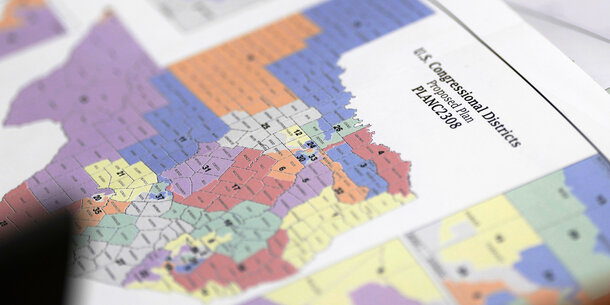Florida, Georgia, Texas, and North Carolina likely hotspots for partisan and racial gerrymandering due to changes in demographics and the law, and single-party control of map-drawing
Redistricting reforms and political wins resulting in divided government in some states improve the chances for fair maps: Colorado, Louisiana, Michigan, New York, Ohio, Pennsylvania, Utah, Virginia, and Wisconsin
The next round of redistricting in 2021 and 2022 is likely to be the most challenging in recent history and particularly detrimental to communities of color, according to a report by Michael C. Li, one of the nation’s leading experts on redistricting and gerrymandering and senior counsel at the Brennan Center for Justice at NYU Law.
The Redistricting Landscape, 2021–22 provides an overview of the battles ahead over the political maps being drawn this year and next that will apply to Congress and state legislatures for the next ten years. The report categorizes the 50 states according to their projected risk for partisan gerrymandering and/or racially discriminatory maps.
“Expect a tale of two countries,” Li writes. “In parts of the country, newly enacted reforms and divided government will make it harder to force through partisan gerrymanders or racially discriminatory maps. In other states, however, there may be even greater room for unfair processes and results than in 2011, when the country saw some of the most gerrymandered maps in its history.”
The risk for abuse in map drawing will be especially high in the South, where fast population growth and demographic change in Texas, Florida, Georgia, and North Carolina will combine with single-party control of the process and weaker legal protections for communities of color.
“By striking down Section 5 of the Voting Rights Act and making other key provisions of the Voting Rights Act harder to use, the Supreme Court has left Black and Latino voters with fewer voting protections than at any time since the 1960s,” Li notes. “At the same time, the South has become more racially and politically diverse, posing a serious new threat to the longstanding status quo of white Republican dominance. Look for some of this decade’s biggest fights to be over rapidly diversifying suburbs of the southern cities like Atlanta, Dallas, and Houston.”
In addition to gerrymandering abuses in the South, Li sees improvements in six states that are debuting reforms passed by voters: Colorado, Michigan, New York, Ohio, Utah, and Virginia. The reforms create strong independent commissions in Michigan and Colorado that will take over redistricting responsibilities from state legislatures and draw both congressional and legislative maps. In New York and Utah, new advisory commissions will present nonbinding maps for legislative approval. In Virginia, a bipartisan commission will draw both congressional and legislative districts. And Ohio voters approved constitutional amendments to incentivize more bipartisan line drawing. Court rulings striking down partisan gerrymanders under state law in Pennsylvania and/or election of divided governments in Pennsylvania, Wisconsin, and Louisiana, have improved the prospect for fairer maps in those states.
Other highlights from The Redistricting Landscape, 2021–22:
- Republican single-party control of the redistricting process will continue to be the norm in much of the country. Republicans will have sole control over drawing congressional maps in 18 states and legislative maps in 20 states, while Democrats will have sole control of congressional maps in 7 states and legislative maps in 9 states. These single-party-controlled states include Florida, Georgia, North Carolina, and Texas. All told, Republicans will have sole control over the drawing of 181 congressional seats compared to 49 for Democrats.
- Together, Latino, Black, and Asian American voters will account for 80 percent of the country’s increase in eligible voters between 2010 and 2020, according to the report’s projections. Since 2011, the number of eligible Black, Latino, and Asian American voters has grown at an extraordinary rate, with Latino Americans alone responsible for 40 percent of the increase in the country’s eligible voters.
- Alabama, Mississippi, and South Carolina have a high risk of manipulated maps. Although they are not growing or changing demographically as fast as the highest-risk states, these three states were formerly covered by Section 5 of the Voting Rights Act and will also draw maps this decade under single-party control.
- Arizona, California, Illinois, and Washington saw significant nonwhite population growth in certain regions in the last decade and could see fights over demands for increased representation for growing communities of color.
- Delays in the release of 2020 census numbers because of the Covid-19 pandemic will create significant timing challenges in several states. In Virginia, this will make it virtually impossible to draw new maps before scheduled legislative elections, forcing the state to use existing maps for its 2021 elections. In other states, the delay in receiving data could push redistricting into special legislative sessions, where there are fewer procedural protections and more opportunities to manipulate the process. Other states, like Illinois, will need to change legal deadlines for completing redistricting to avoid defaulting to a backup commission that could be controlled by the minority party (Republicans).
- This cycle of redistricting may bring efforts to draw legislative or local government districts based on adult citizen population rather than total population, the long-standing practice in all 50 states. (This risk does not apply to congressional districts.) Such a switch would devastate representation for growing Latino and Asian American communities. Black communities would also be hit hard. Cities and suburbs would lose representation to more rural parts of states.
- In January, the House introduced the For the People Act (H.R. 1), a set of democracy reforms that would bring key improvements to redistricting nationwide. The bill includes a ban on partisan gerrymandering and would establish uniform national rules for map drawing, including enhanced protections for communities of color.
“H.R. 1 could be a game changer for redistricting if Congress acts quickly,” says Li. “Without H.R. 1, states like Texas and Florida almost certainly will see another round of aggressive map drawing at the expense of communities of color. H.R. 1 would create a fairer process and give communities of color new tools to fight back.”
To read the full report, click here.

